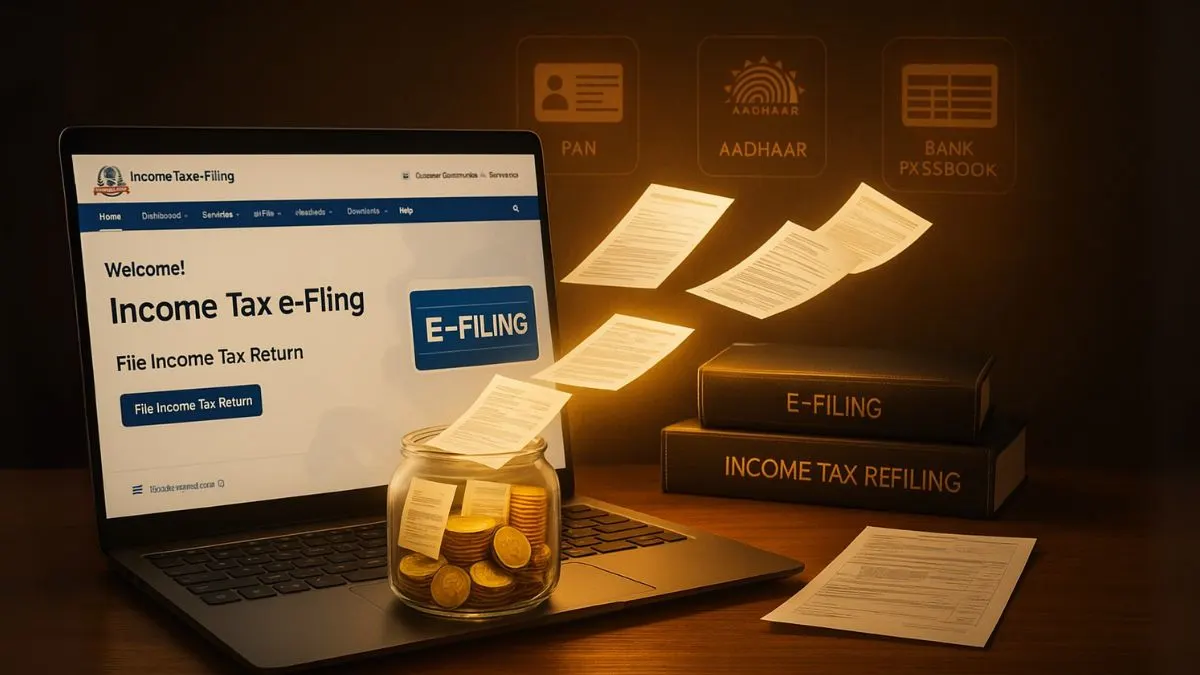
E-filing simply means filing your income tax return or other forms online through the government’s official e-filing portal. Instead of submitting paper-based returns at the Income Tax Office, taxpayers can now log in to the e-Filing system and file their returns digitally.
It applies to individuals, salaried employees, businesses, companies, and even charitable trusts. The portal allows taxpayers to perform multiple tasks—from uploading ITRs to paying advance tax, downloading PAN card, or linking Aadhaar.
Why is E-filing Important?
The traditional paper-filing method was time-consuming & prone to errors. E-filing solves this by making tax compliance fast, transparent, and accessible. Here’s why it is important:
- Accuracy: Auto-filled forms reduce mistakes.
- Convenience: Accessible 24/7 from anywhere."
- Speed: Instant acknowledgment of filed returns.
- Refunds: Faster processing of income tax refunds.
- Environment-friendly: Eliminates the need for physical paperwork.
The E-filing Portal
The government of India has set up a dedicated e-Filing portal (www.incometax.gov.in). This is a one-stop platform where taxpayers can:
- File income tax returns (ITRs)
- File TDS and other statutory forms
- Pay advance tax and self-assessment tax
- View Form 26AS & AIS (Annual Information Statement)
- Track refund status
- Link Aadhaar with PAN
- Rectify mistakes in filed returns
- Raise grievances and track status
This portal ensures that every taxpayer can manage their tax obligations without needing to physically visit any office.
Also Read: PAN-Aadhaar Not Linked Yet? New Circular Brings TDS/TCS Relief for Taxpayers and Deductors
E-filing of Income Tax Return or Forms
The e-Filing of Income Tax Return or Forms is the heart of the system. Depending on the type of taxpayer, different ITR forms are available online:
- ITR-1 (Sahaj): For salaried individuals with income up to ₹50 lakh.
- ITR-2: For individuals and HUFs not carrying business.
- ITR-3: For business or professional income.
- ITR-4 (Sugam): For presumptive income taxpayers.
- ITR-5/6/7: For firms, companies, LLPs, & trusts.
The portal provides guidance to select the correct form, ensuring compliance. Taxpayers can also download pre-filled JSON/Excel utilities to file offline and then upload online.
How to Use the E-filing System?
Step 1: Register/Login
Go to the e-Filing portal & log in using your PAN, Aadhaar, or registered credentials. First-time users need to register.
Step 2: Choose E-filing Option
Click on “e-File” → “Income Tax Returns” → “File Income Tax Return”.
Step 3: Select Assessment Year and ITR Form
Choose the assessment year (e.g., AY 2025–26) and the relevant ITR form.
Step 4: Pre-fill and Verify Details
The system auto-fills data such as salary, TDS, and bank details. Cross-check everything."
Step 5: Submit and E-verify
Submit the return & e-verify via Aadhaar OTP, Net Banking, or DSC. Only after e-verification is the return treated as valid.
Benefits of E-filing System
The e-Filing system is a game-changer for taxpayers:
- Time Saving: No more queues at the Income Tax Office.
- Security: Data is encrypted and stored safely.
- Cost Effective: Reduces paperwork and associated costs.
- Transparency: Clear status updates on refunds & processing.
- Easy Corrections: Mistakes can be rectified online.
Also Read: Filing ITR-2? One Mistake Could Delay Your Refund—Here’s the Right Way to Do It!
Common Mistakes to Avoid While E-filing
While the e-filing system makes tax compliance easier, many taxpayers still commit avoidable errors:
- Using the wrong ITR form.
- Failing to e-verify the return.
- Not reporting interest income from savings account or FDs.
- Mismatching data with Form 26AS or AIS.
- Not pre-validating bank account for refunds.
Avoiding these ensures smooth processing & prevents penalties.
E-filing Services Beyond ITR Filing
The e-Filing portal is not just about filing returns. It offers a wide range of services:
- PAN services: Download e-PAN, update details.
- Aadhaar linking: Mandatory for PAN validity.
- TDS management: File TDS returns, corrections.
- Refund tracking: View real-time refund status.
- E-payments: Pay taxes directly via Net Banking, UPI, or debit card."
- Compliance check: View outstanding demands or notices.
This makes it a holistic tax management platform.
Refunds Through E-filing
Once an ITR is filed through the e-Filing system, the Income Tax Department processes it & calculates refund eligibility. Refunds are faster under e-filing compared to physical returns. Taxpayers can check refund status on the portal within 10 days of processing.
Future of E-filing in India
With AI, machine learning, and data analytics, the future of the e-Filing system is even brighter. Soon, taxpayers will have more pre-filled data, simplified utilities, and reduced manual entries. This will further improve compliance and reduce tax evasion.
Also Read: ITR-3 Filing Simplified: What is the ITR 3 form? How to file ITR-3?
Final Thoughts
The e-Filing of Income Tax Return or Forms has brought a digital revolution in India’s tax system. It has made compliance faster, simpler, & more secure. Every taxpayer—whether salaried, business owner, or professional—should embrace this system for hassle-free compliance.
👉 Want your taxes filed with 100% accuracy? Get expert help with e-filing at Callmyca.com and enjoy peace of mind while we handle the paperwork for you.











